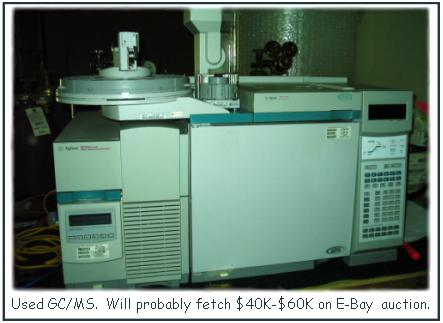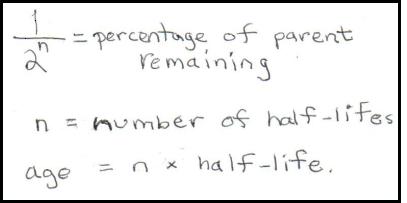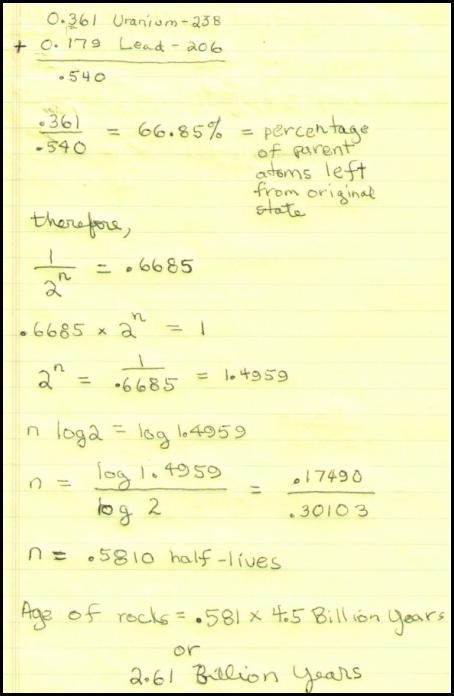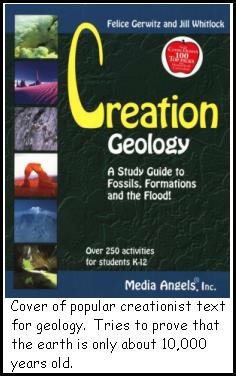Math, Science, and Philosophy for the Folks in the Pews:
Chapter One. The Mass Spectrometer and the Age of the Earth
by
Warren F. O'Rourke
Table of Contents
Introduction
Section I. The Importance of GC/MS Analysis in Scientific Research
Section II. Some Simple (But Necessary) Geology, Physics, and Math
Section III. How GC/MS Actually Works
Conclusion
Appendix A. Common Uses of GC/MS Analysis
Appendix B. Limitations of GC/MS Technology
Appendix C. How Old is the Earth?
Introduction "Usually, even a non-Christian knows something about the earth, the heavens, and the other elements of this world, about the motion and orbit of the stars and even their size and relative positions, about the predictable eclipses of the sun and moon, the cycles of the years and seasons, about the kinds of animals, shrubs, stones, and so forth, and this knowledge he holds to as being certain from reason and experience. Now, it is a disgraceful and dangerous thing for an infidel to hear a Christian, presumably giving the meaning of Holy Scripture, talking nonsense on these topics; and we should take all means to prevent such an embarrassing situation, in which people show up vast ignorance in a Christian and laugh it to scorn. The shame is not so much that an ignorant individual is derided, but that people outside the household of the faith think our sacred writers held such opinions." -- from The Literal Interpretation of Genesis, St. Augustine of Hippo, 5th Century A.D."The only way we can determine the true age of the earth is for God to tell us what it is. And since he has told us, very plainly in the Holy Scriptures that it is several thousand years of age, and no more, that ought to settle all questions of terrestrial chronology." -- from The Remarkable Birth of Planet Earth, Henry Morris, 1972.
"Dr. Kent Hovind, a high school science teacher for 15 years, is now considered one of the foremost authorities on Science and the Bible. He will be speaking about Lies in the textbooks, Dinosaurs and the Bible, and Why evolution is stupid." -- from an online ad announcing the speakers for the "first ever" Creation Boot Camp at Marcus Pointe Baptist Church, Pensacola, Florida, 2005.
"I think Christians should be scrupulously honest and above reproach when they are engaged in scholarly pursuits such as science. Instead they have a reputation for being a bunch of loons. It harms the cause of Christ." -- from the personal website of Steve Schimmrich, a Christian geologist, 2008.
"I believe in God, the Father Almighty, maker of heaven and earth." -- from The Apostles' Creed.
"But I say unto you, That whosoever is angry with his brother without a cause shall be in danger of the judgment: and whosoever shall say to his brother, Raca, shall be in danger of the council: but whosoever shall say, Thou fool, shall be in danger of hell fire." -- Matthew 5:22.
Ever since the time of St. Augustine, careful Christian thinkers have worried that ignorant believers do more to drive people away from Christianity than the actual enemies of the faith. Remember the old saying? "With friends like them, who needs enemies?"
Clearly Henry Morris and Kent Hovind are merely two of the sort of Christians whose "vast ignorance," as St. Augustine feared, would cause non-Christians to mock our faith and our scriptures. And despite Matthew's warning about calling our fellowmen fools "without a cause," even the most charitable of educated Christians is sorely tempted to exclaim that Morris and Hovind are very great fools indeed. As Steve Schimmrich says in the passage quoted above, such Christians seem to the rest of us "like a bunch of loons. It harms the cause of Christ."
But nowadays advocates of "intelligent design" and "young earth creationism" as well as various anti-evolution organizations are busily circulating all sorts of nonsense in an effort to prove that a literal reading of Genesis is justified. As Stephen Jay Gould said in his 1991 essay "Genesis and Geology," "biblical literalism will never go away, so long as cash flows and unreason retains its popularity." Recently the subject of such fundamentalist literalism has been coming up for criticism in my Sunday school class. Clearly it's time for me to organize a few thoughts to assist both me and my fellow students in forming intelligent opinions about such issues as the age of the earth. After all, really knowing some of the details of the current state of scientific knowledge about the age of the earth ought not to threaten anyone's belief that God created the earth.
Don't misunderstand me! I suspect that everyone in my Sunday school class already accepts the notion that the earth is billions of years old and that Genesis is not book of accurate geology, but most of those folks have never had the opportunity to study and master in detail the science and mathematics that supports that notion. My fellow students mostly accept the idea of a very old earth because it has been frequently repeated to them by people whom they trust and respect. That's fine, but for anyone in the pews and Sunday school classes who wants to really understand the scientific and mathematical reasons why the earth was not created in six literal days and why the earth is far older than the six or seven thousand years claimed by many "young creationist" fundamentalists, what follows is a simple version of a small part of that science and math which demonstrates that the earth is about 700,000 times older than the young earth fundamentalists claim.
Let's begin with a scientific instrument that can be used to measure the age of the earth's surface rocks, the gas chromatograph/mass spectrometer, which is most commonly called a GC/MS.
Section I. The Importance of GC/MS Analysis in Scientific Research "Worshipping the results of our technology is clearly wrong, as well as just plain stupid. Isaiah 44:9-20 tells about someone making an idol and then worshipping it." -- from the personal website of Robert LaBar, head of Science Division, Southern Wesleyan University, 2008."The GC/MS test is virtually error free." -- from "How to Pass a Drug Screen," an online site advising drug-users about how to thwart the various tests used to determine drug use, 2008.

Well, Dr. LaBar, I'm just an inch or two away from worshipping a piece of technology. The GC/MS is a basic tool of modern scientific research confidently used by thousands of scientists in hundreds of labs every day. Simply put, it tells you with astonishing accuracy what atoms, isotopes, and molecules are present in a sample being investigated.
There is an on-line company named LabX which sells new and used scientific lab equipment and lab supplies: surplus instruments, replacement parts, chemical and radioactive substances, and so forth. That outfit claims that over the past eight years they have sold over 200,000 reconditioned gas chromatograph/mass spectrometer tandems! Also there are many different manufacturers of new GC/MS units: Agilent, Finnegan, Varian, and Hewlett-Packard just to mention a few. Those companies and others like them make all sorts of varieties of GC/MS for specific applications in fields such as geology, criminal forensics, medicine, drug testing, atmospheric analysis, petroleum and mineral exploration, and many others. Public health and medical researchers have used the GC/MS to analyze which compounds cause the bad smells from paper mills, stockyards, and human halitosis. GC/MS analysis is used to investigate charges of horse-doping at major race tracks such as Churchill Downs. The F.B.I. scientists who investigated the 1995 bombing of the Murragh Federal Building in Oklahoma City used GC/MS to identify exactly what substances were used to make the explosives. NASA has even sent GC/MS instruments to the Moon and Mars to find out the composition of surface rocks on those distant bodies. And, if you want to set up your own properly equipped lab and if you have plenty of money, you can go on E-Bay and bid for your own reconditioned unit. In other words, if you live near a university or a medium-sized or larger town or city, you can be sure that there are several of these instruments operating within a fifteen minute drive of your home. The GC/MS is a technology nearly as common and even more reliable than cell phones or lap-tops.
In brief, almost all chemists consider a properly set up GC/MS indispensible for the analytical part of their work. (See Appendix A. below for numerous other examples of real-world uses of GC/MS technology.)

Actually, if you watch TV crime dramas such as CSI: Miami or NCIS, you have already seen the GC/MS at work in a dramatic though somewhat fictionalized way.
Agent Gibbs: "Abby, tell me what's in this salt shaker besides salt. The shaker was in the victim's hand."
Abby: "Sure, boss!" (And she pops a dash of the shaker's contents into her GC/MS, dramatic music plays, and in thirty seconds, a computer printout appears.)
Gibbs: "What have you got?"
Abby: "Well, there's enough arsenic mixed in that salt that a couple of shakes would kill a healthy male. And, better than that, it's a type of arsenic that used to be in insecticides. And the only place around here where you can find that kind of arsenic would be at the old insecticide factory out on Route 30."
In a real crime lab it would have taken a couple of hours to run the test two or three times to make sure the results were consistent and, of course, the GC/MS would not have known where the arsenic came from unless that information was already programmed into the computer that analyzed the data. Nevetheless, the basic point was correct. Provided that the technician calibrates and operates the machine properly and avoids introducing contaminated samples into the instrument, the GC/MS is capable of quickly and accurately identifying substances and the amounts in which they are present in trace evidence found at a crime scene. (For more about the complications and limitations of GC/MS analysis, see Appendix B. below.)
But it's not only the scientists and forensics lab people who have confidence in the GC/MS. The lawyers are in on this, too! Evidence produced by GC/MS analysis is admissible in American courts and is so persuasive that both prosecutors and defense lawyers attend seminars that teach the attorneys how the GC/MS works and how to effectively use or attack such evidence as either a prosecutor or as a defendant's advocate. An example of some online materials from such a seminar are provided by an attorney named Frederic Douglas in his article "GC/MS Testimony" in Scientific Testimony: An Online Journal. (I refer to this article with pleasure despite the fact that it was written by an attorney. It has some of the clearest available explanations of how a GC/MS actually works.)
I'll come back to the workings of the GC/MS a little later, but let's look at a little simple geology, a little simple math, and a very little simple physics. Ah, I can almost hear some of my Gentle Readers exclaiming "there's no such thing as simple math! And there absolutely is no such thing as simple physics!" (If you simply cannot hack the math and science in the next section, just read the first few paragraphs and then skip on to the next section.)
Section II. Some Simple (But Necessary) Geology, Physics, and Math "Math ain't really hard. It's just so damn boring!" -- Source unknown."If you are given the length of two sides and the angle measure opposite one of those sides, you can use the law of sines to solve the triangle. However, this does not always determine a unique triangle. As a result, it is called the ambiguous case. Ambiguous means open to multiple interpretations. Some people say that you can interpret the Bible in any way that you want. However, there is no ambiguity in the Bible." -- from Pre-Calculus for Christian Schools, Kathy D. Pilger and Ron Tagliapietra, Bob Jones University Press, 2002.
The main geology point of this section is that nearly all the rocks in the crust of the earth are more or less radioactive because they nearly all contain varying amounts amounts of uranium or other radioactive elements.
The main physics points of this section are that Uranium-238 slowly decays into Lead-206 and that physicists call the uranium "the parent atom" and the lead "the daughter atom." The rate of decay from uranium to lead is called " the half-life." In the case of naturally occurring uranium that half-life is about 4.5 billion years. In other words, it take 4.5 billion years (or one half-life) for one-half of the parent uranium to decay into the daughter lead. After two half-lifes only one fourth of the original parent atoms are left. After three half-lifes only one-eighth of the original parent atoms of uranium are left because seven-eighths of the uranium atoms have turned into lead.

The main math points in this section are that (a) anyone who can still handle pre-algebra concepts like exponents and logarithms can understand the math and that (b) the formulas, as you can see in the box to the right, are really very simple and can be solved with the help of any ordinary scientific calculator such as my Texas Instruments TI-34 II or my Texas Instruments TI-30Xa or my Casio fx-260. (Those are the kind of calculators which you can get at Walmart in the back-to-school supplies section and which nearly every high school kid uses with ease.)
I know! I know! Some of you really hate math. Suffice it to say that, if you have a way to measure what percentage of the original parent atoms are left in a sample rock, it is very easy to calculate the age of the rock. Well, that percentage of parent atoms is exactly one of the things that a GC/MS can measure accurately as long as the technician who does the measuring is competent and careful.
If, Gentle Readers, the math is depressing you too much, this is probably where you should skip ahead to the next section. That's where we will be discussing how a GC/MS actually works. If you stick with this section, we are going to work out a hypothetical case of trying to date some rocks. (Skip to next section.)
Suppose that geologists working in Greenland find what they think are some very old rocks and they send some samples to your lab for GC/MS analysis. What happens next is that you make sure the technician who operates the machine has cleaned it properly and then recalibrated it to make sure it is giving accurate readings. Then you are ready to start testing the samples. To make sure there is no surface contamination on your samples, you chip off five small slivers of rock that have never before been exposed to surface contamination; then one by one, you test each sample in the GC/MS, record the results, and then you recalibrate and re-clean the machine before testing each new sliver.
Your GC/MS readings are averaged together and here are your results: 0.361% of the material in your samples is Uranium-238, the parent isotope; 0.179% of the material in your samples is Lead-206, the daughter isotope. Here, then, are the calculations:
If there's a high school math teacher in the house, you can get her to reassure you that I did the logarithm equations correctly and that the calculations above demonstrate that these rock samples are very close to 2.61 billion years old. And what that tells us is that our planet is at least 2.61 billion years old because the planet cannot be younger than the oldest rocks found on the planet. (In the real world, so far the oldest rocks found by this method are about 3.5 billion years old.)
And, by the way, how do I know that the half-life figure of 4.5 billion years is a good approximation of the decay rate of Uranium-238? Well, because the National Institute of Standards and Technologies says so. Formerly known as the U.S. Bureau of Standards, the NIST has bunches of scientists with fancy geiger counters and extremely accurate chronometers who keep measuring the decay rates of Uranium-238 and getting more and more accurate estimates of that isotope's half-life. The current NIST estimate is 4.51 billion years. And that estimate is very, very close to what European, Asian, and African scientists have independently calculated.
So now we need to see how the GC/MS actually works. How does it perform these miraculously accurate measurements?
Section III. How GC/MS Actually Works "The account of Noah and the Ark is one of the most widely known events in the history of mankind. Unfortunately, like other Bible accounts, it is often taken as a mere fairy tale. The Bible, though, is the true history book of the universe, and in that light, the most-asked questions about the Ark and Flood of Noah can be answered with authority and confidence. . . The history of God’s creation (told in Genesis 1 and 2) tells us that all the land-dwelling creatures were made on Day 6 of Creation Week—the same day God made Adam and Eve. Therefore, it is clear that dinosaurs (being land animals) were made with man. . . Widespread legends of encounters with dragons give another indication that at least some dinosaurs survived the Flood. The only way this could happen is if they were on the Ark. . . For example, God most likely brought Noah two young adult sauropods (e.g., apatosaurs), rather than two full-grown sauropods. . . Creation scientists suggest that God gave the animals the ability to hibernate, as we see in many species today." -- from "Was There Really A Noah's Ark and Flood," Ken Ham and Tim Lovett, 2007.
As the quote from Ham and Lovett above shows, some of the stuff creationists spout is plain nutty. Nevertheless, many students who are being home-schooled or who attend church-operated schools use textbooks such as Ham and Lovett or the one depicted here. And the movement known as "intelligent design" has tried its best to have such books adopted in our public schools. This particular book tries to show that the earth is less than 10,000 years old and that much of the present geological structure of the earth is a result of forces at work during Noah's Flood. If you become familiar enough with the real science of determining the age of the earth, you cannot help being embarrassed by much of the content of such books, and I am sure I would be very angry if I learned that my local public school was teaching such nonsense to my children. I think the scientists who developed GC/MS technology inspire me to greater trust than someone who argues with a straight face that Noah saved space on the Ark by bringing a pair of baby dinosaurs on board rather than enormous and difficult to care for adult dinosaurs.
So let's turn to the main point of this section: an explanation of how and why the GC/MS actually works so well that scientists can confidently give the age of some of the earth's rocks as 3.5 billion years old.
Well, the first thing you need to know is that the GC/MS is really two different instruments hooked up in tandem: (a) the gas chromatograph; and (b) the mass spectrometer:
(a) The GC essentially is used to separate a substance of unknown composition into the various chemical compounds present in the substance. A vaporized sample of the substance being analyzed is passed through a long thin tube called a column filled with an inert gas like helium or argon. Lighter and simpler molecules pass through the column more quickly than heavier and more complex molecules. In fact, each molecule has a distinct retention time, i.e., the time it takes for a particular type of molecule to make it to the end of the column. Electronic detectors at the end of the column record the time it takes for each compound to make it through the column and then searches a computer data base to locate the compounds that are known to have the same retention time. The results are printed out graphically.
(b) As each compound exits the GC, it immediately enters the MS where it passes through an electromagnetic field. The molecules are deflected more or less from their original path depending on the mass and the electrical charge of the molecules. The results of the deflection is recorded by electronic detectors and recorded on graphs that look very much like the GC graphs. In simple terms, the molecules have been separated from one another a second time and the results have been sent to a computer data base for comparison to see if there is a match for the current experimental data in the data base. In a way, it's like trying to match up the fingerprint you have found with a data base of known fingerprints.
The results of all this separating and comparing to known substances boils down to this one amazing fact. GC/MS instruments are able to detect the presence of substances to an accuracy of three or four parts per billion. Not only that, I have heard that newer GC/MS methods are being developed all the time and that accuracies of a few parts per trillion will soon be available.
"The true delight is in the finding out rather than in the knowing." -- Isaac AsimovWhen I was in high school and college, Gentle Readers, I read everything that I could find by Isaac Asimov. I once heard him on a radio broadcast back in the 1960's saying that his many essays and books were written mainly to explain to himself in the simplest terms possible the scientific or mathematical details that he had studied most recently and to allow anyone who is interested to read the marvelous things he had say to himself about what he had just found out. (By the way, I borrowed the practice of addressing my audience as "Gentle Readers" from Asimov.)
What the essay above and the appendices below comprise is my essay to myself about the role of radiometric dating in determining the true age of the earth and also some of the foolishness associated with biblical literalism. If, Gentle Readers, you are interested enough to read this, maybe you will experience some of the "true delight" Asimov spoke of. In any event, this is only Chapter One. If you didn't enjoy this one, be on the look-out for Chapter Two.
Appendix A. Common Uses of GC/MS Analysis Here are many of the uses to which GC/MS is being put nowadays:
1. GC/MS has been used to detect use of steroids and other forbidden drugs by both professional and Olympic athletes. (Ever since 2000, sports authorities have been working to develop ever more accurate GC/MS testing procedures to expose athletes who have used forbidden drugs to enhance their perfromances.)
2. GC/MS is regularly used by anesthesiologists to monitor the breath of surgical patients.
3. GC/MS has been used on space probes to determine what molecular compounds are present on the surface and in the atmospheres of such places as Mars, the Moon, and the satellites of Saturn such as Titan.
4. GC/MS has been used to prove that a major distributor of honey was adulterating its product with corn syrup.
5. GC/MS is used by the major oil companies to locate oil deposits by measuring petroleum precursors in likely rock formations.
6. GC/MS is regularly used by major breweries to monitor and control the fermentation process in the manufacture of beer.
7. GC/MS is regularly used by public health authorities to detect such health hazards as dioxins in contaminated fish, salmonella in fruits and vegetables, and fecal matter in flour, oatmeal, and other stored grains.
8. GC/MS is used by the federal government as a back-up test in their drug-screening programs to identify "false positives" from cheaper, faster, and less accurate screening methods.
9. GC/MS has become an important tool for proteomics, the study of cellular proteins. The technology can also be used to identify and analyze other organic molecules such as DNA and RNA. (I know! I know! I never heard of proteomics until I started researching for this essay!)
10. GC/MS has been used by Carnegie Mellon University's Mark Bier to rapidly identify viruses and thereby greatly speed up diagnosis of viral diseases and to gain new insights into the cure and treatment of viral diseases.
11. GC/MS has been used to prove that a major pharmaceutical manufacturer was negligent in allowing traces of solvents from the manufacturing process to contaminate the product which they distibuted for sale.
12. GC/MS has been used to identify the presence of poisonous substances such as anthrax.
13. GC/MS was used in efforts to determine the true age and nature of the Shroud of Turin.
14. GC/MS is regularly used to determine what pollutants are in the atmosphere.
15. GC/MS has been used to determine the age and origin of geological and archaeological specimens.
16. GC/MS was used to link an abortion clinic bombing in Birmingham with another bombing in Altlanta.
17. GC/MS is often used to determine cause of death in autopsies of suspected drug overdose victims.
18. GC/MS is used to detect doping of horses at major race tracks in England and the U.S.
19. GC/MS has been used to determine what chemicals are present in cases of severe human halitosis.
20. GC/MS has been used to determine the chemicals causing unpleasant odors at paper mills, chemical plants, stockyards, and so forth.
Appendix B. Limitations of GC/MS Technology
As highly as I have praised the GC/MS technology in this paper, and as often as you will hear the technology referred to as "the gold standard" of chemical analysis, it is nevertheless true that the technology has its limitations. To begin with there are an estimated thirty million chemical compounds mentioned in the professional literature. Some of these compounds are so rare that it is difficult to get reference samples of these substances; other man-made compounds are patented by chemical companies who consider the details about such substances as trade secrets and thus have not provided reference samples to the scientific community at large. Thus it happens that the characteristic profiles of many compounds are not included in the computer files of most GC/MS instruments. Typically, the library of computer profiles in most GC/MS instruments is limited to about five or six thousand substances.
Another limitation that is especially important in trying to date the age of rocks in earth's crust comes from the fact that samples of rocks may be composed of aggregated rocks of many different ages. Another difficulty is that over geological time sample rocks may have been subjected to forces that alter the proportions of the compounds in the rocks.
Still another problem is that some rocks contain highly reactive compounds that tend to react further while being analyzed by GC/MS instruments. And that throws off the analysis by seeming to report the presence of compounds in the sample that actually developed only during the process of analysis.
And still another problem is that the least bit sloppy work by lab techs who operate the instrument can completely muddle the results of an analysis. Unfortunately, not all GC/MS technicians are of equal skill and sometimes commerical laboratories take short-cuts in order to enhance profits. The more analyses a commercial lab can turn out each day, the more profitable the lab becomes.
Nevertheless, when GC/MS works, it works wonderfully well. When it is used inappropriately or carelessly, it is not worth much at all! Young Earth Creationists sometimes latch on to such admissions as this one in hopes of discrediting radiometric dating as a valid technique in all cases, but the real significance of the acknowledged limitations is that technicians have developed elaborate precautions to prevent errors due to the limitations.
By running multiple analyses of the same substance, by continually re-calibrating the instruments, by making sure there are no contaminants in the instrument, by updating whenever feasible the computer libraries used in GC/MS, and by having the same substance analyzed by several labs using different instruments -- by these kinds of precautions and safeguards, GC/MS results can turn out to be amazingly accurate. Properly conducted radiometric estimates of the ages of rocks are the best scientific evidence available for forming an estimate of the earth's age.
Appendix C. How Old is the Earth? Obviously the earth can be no older than the oldest rocks which are found on the planet. Those oldest rocks are meteorites, that, is hunks of debris left over from the formation of the planets and their satellites. Occasionally these relics from the beginning of the Solar system find their way to the earth's surface or to the surface of the moon. Hundreds, perhaps thousands, of meteorite samples have been collected on Earth and on the Moon. GC/MS dating of these samples gives us an average age of 4.53 billion years +/- 100 million years. That 100 million year margin of error represents roughly a 2 percent error. In other words, we are about 98% sure that the earth is 4.53 billion years old, and almost 100% sure that the correct age of the Earth is between 4.43 billion years and 4.63 billion years.
When you have read through all the material above, it should be pretty clear to you why scientists are convinced they have a pretty accurate knowledge of how old the planet is.

